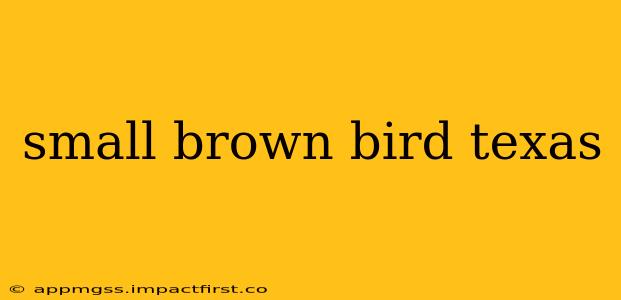Texas boasts a remarkable diversity of avian life, and a significant portion of that diversity falls under the broad category of "small brown birds." Identifying these feathered friends can be challenging, but with a little patience and observation, you can learn to distinguish between the many species that call the Lone Star State home. This guide will help you narrow down your search and potentially pinpoint the exact species you've encountered.
What are some common small brown birds in Texas?
This is a frequently asked question, and the answer depends heavily on the specific location and time of year. However, several small brown birds are particularly prevalent across various regions of Texas. These include, but are not limited to:
- House Wrens: These tiny, energetic birds are commonly found near human habitation, nesting in birdhouses or other cavities. They have a distinctive, somewhat harsh song.
- Brown Towhees: A larger small brown bird, the Brown Towhee exhibits a striking reddish-brown on its flanks and a distinctive white outer tail feathers visible during flight. Their song is a clear, whistled "Drink your tea."
- Bewick's Wrens: Slightly smaller than House Wrens, Bewick's Wrens are also common in urban and suburban areas. Their song is a series of high-pitched, buzzy notes.
- Cactus Wrens: Found in drier, more arid parts of Texas, Cactus Wrens are larger than House or Bewick's Wrens and exhibit a noticeably longer tail.
- Sparrows (various species): Several sparrow species, including the Chipping Sparrow, Field Sparrow, and Song Sparrow, are small brown birds common throughout Texas. Distinguishing between them often requires close observation of markings and behavior.
How can I identify a small brown bird in Texas?
Identifying a small brown bird requires careful observation of several key features:
- Size and Shape: Is the bird relatively small and slender, or is it more robust? Note the length of its tail and the shape of its beak.
- Coloration: While primarily brown, are there any other colors present? Pay attention to the shades of brown (light, dark, reddish, etc.) and look for any hints of other colors on the wings, tail, or breast.
- Markings: Are there any stripes, spots, or other distinctive markings on the bird's head, wings, or back? Even subtle differences can help with identification.
- Behavior: Where is the bird found? What is it doing? Its habitat and foraging behavior can provide valuable clues. Is it hopping on the ground, flitting through bushes, or perched on a branch?
- Song: The bird's song (or call) is often a crucial identification feature. Use a bird identification app to help determine the species based on sound.
What are some resources for identifying small brown birds in Texas?
Several excellent resources can assist you in identifying small brown birds found in Texas:
- Field Guides: Invest in a good field guide specific to Texas birds. These guides provide detailed descriptions, illustrations, and range maps for various bird species.
- Bird Identification Apps: Many apps (e.g., Merlin Bird ID, eBird) use image recognition or sound recordings to help identify birds.
- Online Resources: Websites like the Cornell Lab of Ornithology's All About Birds offer comprehensive information and resources for bird identification.
- Local Audubon Societies: Your local Audubon chapter often conducts bird walks and workshops, providing opportunities to learn from experienced birders.
What are some of the most common habitats for small brown birds in Texas?
The habitats preferred by small brown birds vary considerably, depending on the species. However, many prefer areas with:
- Dense vegetation: Shrubs, bushes, and thickets provide cover and nesting sites.
- Ground cover: Many ground-foraging birds need adequate ground cover for foraging and shelter.
- Water sources: Access to water is crucial for all birds.
- Food sources: Availability of insects, seeds, and berries influences habitat selection.
How can I attract small brown birds to my backyard?
Attract small brown birds to your backyard by providing the necessities for food, water, and shelter:
- Bird feeders: Offer a variety of seeds and nuts.
- Bird baths: Provide a clean source of fresh water.
- Nesting boxes: Offer suitable nesting sites.
- Native plants: Plant native shrubs, trees, and flowers that provide food and cover.
By combining careful observation with the resources mentioned above, you'll be well-equipped to identify those elusive small brown birds in Texas and appreciate the remarkable diversity of avian life in the Lone Star State. Remember that patience and practice are key to successful bird identification.
